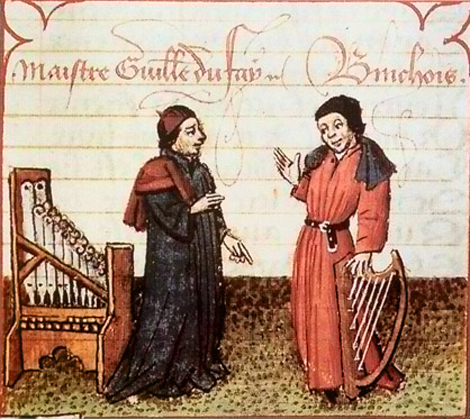
Guillaume Dufay and Binchois
One of my American friends asked me for a list of listening recommendations. She would like to get involved more with music and was wondering what the most essential pieces in the canon are. The idea was to come up with a list of approximately thirty titles which she could listen to and get to know a bit better over the period of a year or so.
Here is the first part of my list. It contains music that was composed up to ca. 1500. Whenever available I linked to the itunes store. This way you can buy the tracks directly if you are interested.
Please let me know what you think about my choice and how this list can be improved. (Use the commentary function below to do so). I am looking forward to hearing from you!
- Chant Wars by Dialogos and Sequentia. A compilation of chant that reflects the confrontation between newly emerging Carolingian repertoires and older local traditions in the 9th century.

- Viderunt omnes by Perotin. This is an example of early polyphony. A four-voice setting of the Christmas gradual by one of the great masters of the late 12th and early 13th centuries. Excellent performance by the Hilliard Ensemble.

- Messe de Nostre Dame by Guillaume de Machaut (ca. 1300 – 1377). A 14th-century setting of the Ordinary of the Mass (i. e. the unvarying chants that were used every day, unlike the Proper of the Mass which contained chants that were specific for a particular day).

- Chansons by Dufay. These wonderful “songs” are gems of Renaissance court culture. I especially like this recording by Bernhard Landauer, Michael Posch, and the Unicorn Ensemble, even though their performance would not satisfy the purists amongst the Early Music crowd. My favorite chansons are Helas mon dueil and Adieu ces bons vins de Lannoys but you should really listen to the whole album!

- Binchois: Chansons. I know it would probably make much more sense to choose some motets by Binchois instead of yet another set of chansons. However I love this album so much, that I cannot hold myself back and urge you to take a close “look” as well. My favorite song is En regardent vostre tres doulx maintiens.

- Josquin: Missa L’homme armé Sexti toni. An entire mass composed on the basis of a secular song.





Great list, thanks for linking the itunes so i could sample. I would love to know more about the first example.
Thanks for the comment, William!
In the 8th century, Charlemagne wanted to unify the liturgy in his dominions. To achieve this he sent singers to Rome who were to learn the Roman way of singing. His idea was that the Roman liturgy and chant whould supplant the local repertories. Since the liturgy played such an important role in daily life, Charlemagne figured that by unifying the way that people sing the liturgy he could excert more power in his lands.
New Grove and Wikipedia have good articles on Chant and Gregorian Chant respectively.
Would you characterize the Roman way as more “advanced,” technically, than the local approaches?
I am not an expert on chant, but some documentary evidence seems to suggest that the Romans were making fun of the coarse voices of the singers that were sent to Rome by Charlemagne. I am not sure about the difference between the repertories. I guess the best place to look this information up is
David Hiley: Western PLainchant. A Handbook. Oxford, 1993.
This is a great list Mattias. I look forward to your next installments. For me, it’s hard to exclude from the above period the Hyperion album “A feather on the breath of God” with sequences and hymns by Hildegard of Bingen. Emma Kirby and Gothic Voices do an amazing job.
I agree, that’s a great album and I should have added it to the list in the first place! Thanks for the recommendation!
A precision: Chant Wars is a coproduction made by two ensembles – Dialogos and Sequentia.
An addition : on iTunes you can find the recent Winchester and Fleury 10th century polyphony CD “Abbo Abbas” by Dialogos too.
Hi Katarina! Thanks for your comment! I have corrected the information and here is a link to the CD you mentioned:
Hi Matthias,
Thanks so much!
All the best
Katarina
Hi Matthias. I can hardly wait to see your future installments! Best, Doug